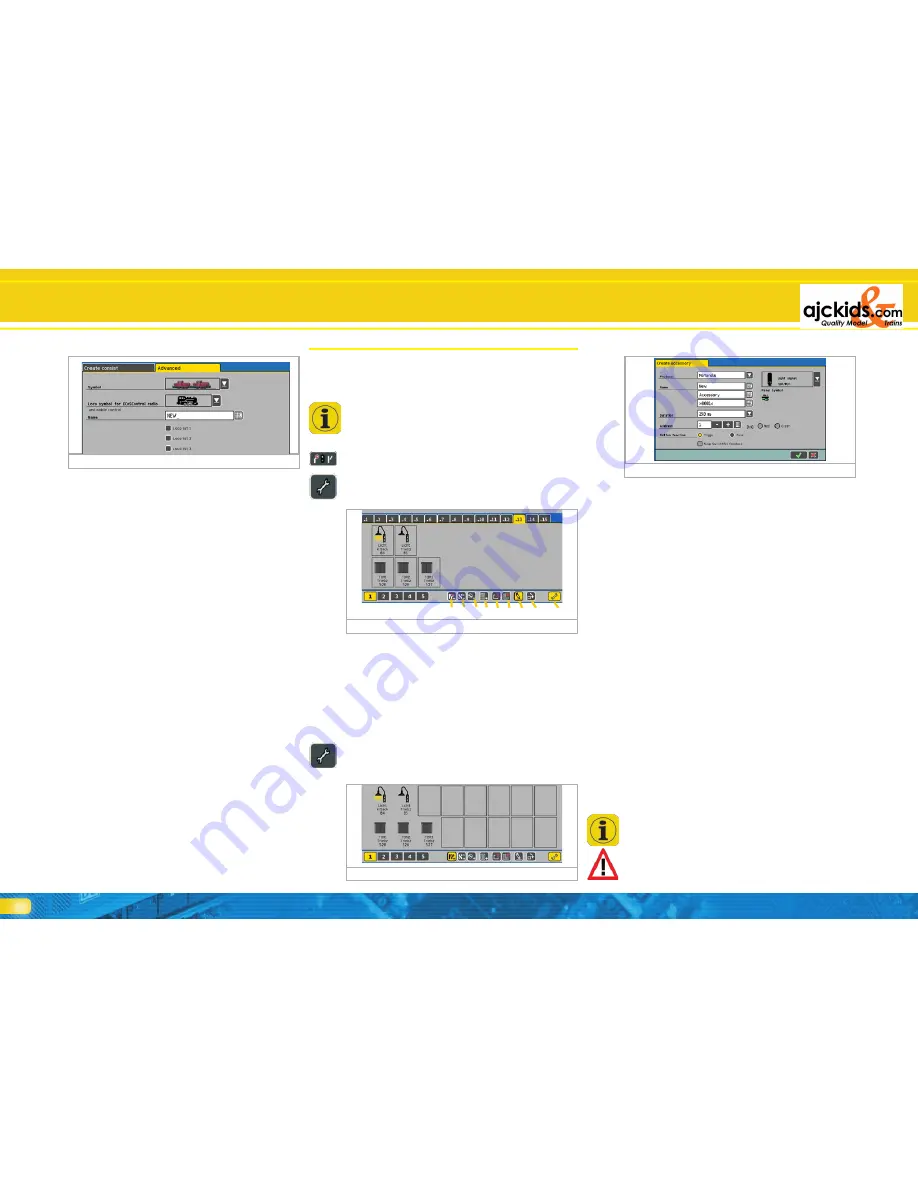
22
13.1.1. Data format
Here you can select the suitable data format to operate your
accessory. DCC, DCC with RailCom® and Motorola® are
available.
13.1.2. Name
For a precise representation on the screen you may give your
accessory a name of up to 3 lines with 9 characters each. The
number depends on the width of the letters and varies bet-
ween 5 and 9 characters.
13.1.3. Number
Enter the number of the corresponding accessory here. You
must enter this value numerically. Please make sure that you
enter a correct number (matching the decoder setting) since
this number is not be double checked by the system.
The corresponding accessory address and output number will
be displayed in parenthesis behind the number. In the example
as per Figure 53 “[3:2]“ indicates that this is the second output
of the third decoder.
13.1.4. Symbol
You should choose the symbol for your accessories as precise-
ly as possible: ECoS recognises two-, three- and four-aspect
symbols and controls through the symbol the outputs of the
accessories accordingly; also refer to chapter 7.4.
ECoS offers a large number of German and international sym-
bols in a choice list.
13.1.5. Permanent versus momentary action buttons
Here you determine if the accessory should be switched for
a pre-determined time (=change over) or only as long as the
button is pressed (=pulse).
Normally you would use the „change over” mode for turnouts.
ECoS transmits a defined, time controlled pulse to the soleno-
id. Thus any burnout of solenoid coils is prevented.
The „Pulse” function is best suited for un-couplers, which
should be active as long as the function is activated (until your
finger leaves the screen button). Furthermore the desired deco-
der output can be selected by choosing “red” or “green”.
The function mode cannot be changed later unless you delete
the accessory and re-enter it.
Figure 55
Operating consists
Figure 54
• Locos assigned to a consist cannot be run individually any
more.
12.2. Assigning a consist to a throttle
Selecting a consist is done the same way as selecting a locomo-
tive. Refer to chapter 11.2. Consists are marked as „Multi” in
the locomotive list.
12.3. Change parameters of consists
You can change any settings in a consist just as easily as with
individual locos, refer to chapter 11.8.
12.4. Deleting a consist
You can delete a consist just as easily as with individual locos,
refer to chapter 11.4.
Any locos that were part of the deleted consist will of course
not be deleted as well. They remain as individual locos in the
list of locos.
12.5. Hints for running consists
• It is recommended only to add locos to a consist that process
the information regarding direction (e.g.: Motorola® II-format;
DCC-format).
• The characteristics of the locos in a consist should be similar
(maximum speed, acceleration and deceleration). There should
not be any big deviations. If necessary reprogram such locos
before adding them to a consist. Also refer to chapter 18.
• Do not couple lightweight vehicles between locos in consists
because of risk of derailment
• Please make sure that any isolated sections ahead of signals
are sufficiently long (at least 36cm to 54cm longer than the
consist) when running consists.
• The first locomotive in the consist determines the mode of
the function buttons. You may adjust this for M4 locomotives.
Thus it is possible to adapt running characteristics and function
mapping.
• Should you wish to run a Märklin® sound car (e.g. 49962
or 49964) together with a locomotive you should locate the
sound car as the first vehicle of the consist. It then determines
the function mapping.
Figure 52
Figure 53
a) b) c) d) e) f) g) h)
i)
13. Switching accessories
Accessories are listed in a library within ECoS similar to locomo-
tives. Thus all accessories have to be entered once before they
can be switched. For switching the accessories will be assigned
to one or several control panels. Normally this happens when
you enter the accessory.
Accessories can be switched with the ECoS only if they are wi-
red to an appropriate decoder. Typical decoders are Märklin®
k83 resp. K84 or ESU SwitchPilot decoders.
13.1. Enter new accessories
• Open the turnout control panel by clicking onto the appropria-
te symbol in the main menu.
• Touch the configuration symbol and the configuration window
will be displayed. There are pictograms at the bottom of the
screen for all important functions.
a) New accessory
b) New route
c) New turntable
d) New link
e) Delete link
f) Delete link and accessory
g) Edit accessory / route / turntable
h) Turn symbol by 90º to the right
i) Exit configuration mode.
• Click onto this symbol in order to enter a new accessory. The
display of the turnout control panel changes to the “grid
mode”. Click onto the field where you want to locate the new
accessory. The following configuration dialogue opens:






























